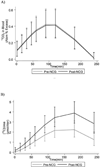Stable isotopes in the diagnosis and treatment of inherited hyperammonemia
- PMID: 24634704
- PMCID: PMC3952002
- DOI: 10.3233/JPB-140106
Stable isotopes in the diagnosis and treatment of inherited hyperammonemia
Abstract
Stable isotopes have greatly contributed to our understanding of nitrogen metabolism and the urea cycle. The measurement of urea flux via isotopic methods has traditionally been utilized to determine total body protein synthesis in subjects with an intact urea cycle. However, isotopic studies of nitrogen metabolism are also a useful adjunct to conventional clinical investigations in the diagnosis and management of the inherited hyperammonemias. Such studies offer a safe non-invasive method of measuring the reduction of in vivo hepatic ureagenesis, and thus may provide a more accurate measure of phenotypic severity in affected patients. In addition, isotopic methods are ideally suited to evaluate the efficacy of novel therapies to augment urea production.
Keywords: Stable isotopes; mass spectrometry; urea cycle disorders; ureagenesis.
Figures


References
-
- Urey HC, Huffman JR, Thode HG, Fox M. Concentration of N-15 by chemical methods. J Chem Phys. 1937;5(11):856–872.
-
- Krebs HA, Henseleit K. Untersuchungen über die Harnstoffbildung im Tierkörper. Z Physiol Chem. 1932;210:33–46.
-
- San Pietro A, Rittenberg D. A study of the rate of protein synthesis in humans. I Measurement of the urea pool and urea space. J Biol Chem. 1953;201(1):445–455. - PubMed
-
- San Pietro A, Rittenberg D. A study of the rate of protein synthesis in humans. II. Measurement of the metabolic pool and the rate of protein synthesis. J Biol Chem. 1953;201(1):457–473. - PubMed
-
- Schoenheimer R, Rittenberg D. The Application of Isotopes to the Study of Intermediary Metabolism. Science. 1938;87(2254):221–226. - PubMed
Grants and funding
LinkOut - more resources
Full Text Sources
